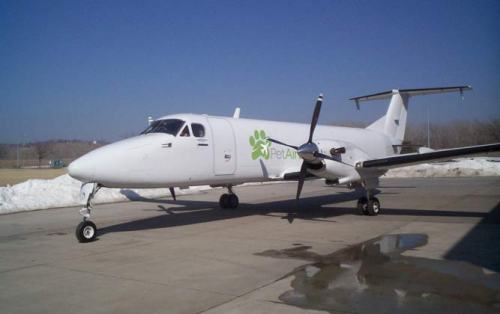
Just as you’d bundle up to brave the harsh winter weather, so too should your pets. Here are a couple suggestions for keeping your pets safe this winter:
- Protect Their Paws —Spray (non-flavored) cookingspray, such as Pam, on your dog’s paws or use Musher’s Wax. Both are effective atpreventing ice from building up and sticking to a dog’s paws
- Try Velcro booties — It may take some desensitizing, but after just a few weeks of practice indoors, your dog will get the hang of them. Start by just showingthe dog the booties and offering a treat. Continue associating the booties with something the dog enjoys. Some dogs may eventually learn that by wearing the booties their paws won’t sting.
- Melt ice and snow from common walkways with animal-friendly salt, such as Morton’s Safe-T-Pet which was developed withveterinarians to be safer for your pets. It’s not only less harsh on pet’s paws, but less damaging to the concrete. If you don’t have safe salt, immediately clean off the paws when you get inside.

- Bundle Up — Put a coat on the dog if it has short hair and shivers when it’s cold. (Leo likes Teckelklub’s Trench in Apple Green!)
- Keep ‘Em Dandy — Brush the dog’s coat regularly to distribute the natural oils in the skin, which will help prevent dry skin.
- Warm Home, Cold Floors – It is important to remember that although your home may be warm, there may still be drafty areas. Make sure your pets have something soft to sleep on (away from drafts) to protect them from the cold floor.
 The twinkle of lights and sprinkle of mistletoe may be nice this time of year, but don’t forget to be mindful of your pets this season. The constant changing environment may create unnecessary stress for dogs and cats. According to a recent press release,
The twinkle of lights and sprinkle of mistletoe may be nice this time of year, but don’t forget to be mindful of your pets this season. The constant changing environment may create unnecessary stress for dogs and cats. According to a recent press release, 

 Late last week, I read an article about a new airline for pets — Pet Airways — that will allow cats and dogs to travel in carriers in the main cabin of the plane, rather than the cargo hold. Unlike other airlines that only allow small animals to fly int he cabin as long as their carriers fit under the seats, Pet Airways will have no limit on size.
Late last week, I read an article about a new airline for pets — Pet Airways — that will allow cats and dogs to travel in carriers in the main cabin of the plane, rather than the cargo hold. Unlike other airlines that only allow small animals to fly int he cabin as long as their carriers fit under the seats, Pet Airways will have no limit on size. about. It appears that the planes are similar to private jets, which means personal attention for all animal passengers and veterinary attention if needed while en route. You can expect flights from five cities in the United States, including Baltimore/Washington International; Midway in Chicago; Rocky Mountain Airport in Broomfield, Colo., near Denver; Hawthorne Municipal Airport near Los Angeles; and Republic Airport on Long Island serving the New York City metro area.
about. It appears that the planes are similar to private jets, which means personal attention for all animal passengers and veterinary attention if needed while en route. You can expect flights from five cities in the United States, including Baltimore/Washington International; Midway in Chicago; Rocky Mountain Airport in Broomfield, Colo., near Denver; Hawthorne Municipal Airport near Los Angeles; and Republic Airport on Long Island serving the New York City metro area. In an earlier post, I wrote about our dog Leo’s separation anxiety and fear of the crate. After month’s of training, he successfully learned to love the crate and went in on command. It was fun watching him run into the crate when we’d say “Go In.”
In an earlier post, I wrote about our dog Leo’s separation anxiety and fear of the crate. After month’s of training, he successfully learned to love the crate and went in on command. It was fun watching him run into the crate when we’d say “Go In.” love the parades, barbeques and fireworks. What better way to spend a hot summer day? Well your pets might not agree.
love the parades, barbeques and fireworks. What better way to spend a hot summer day? Well your pets might not agree.



